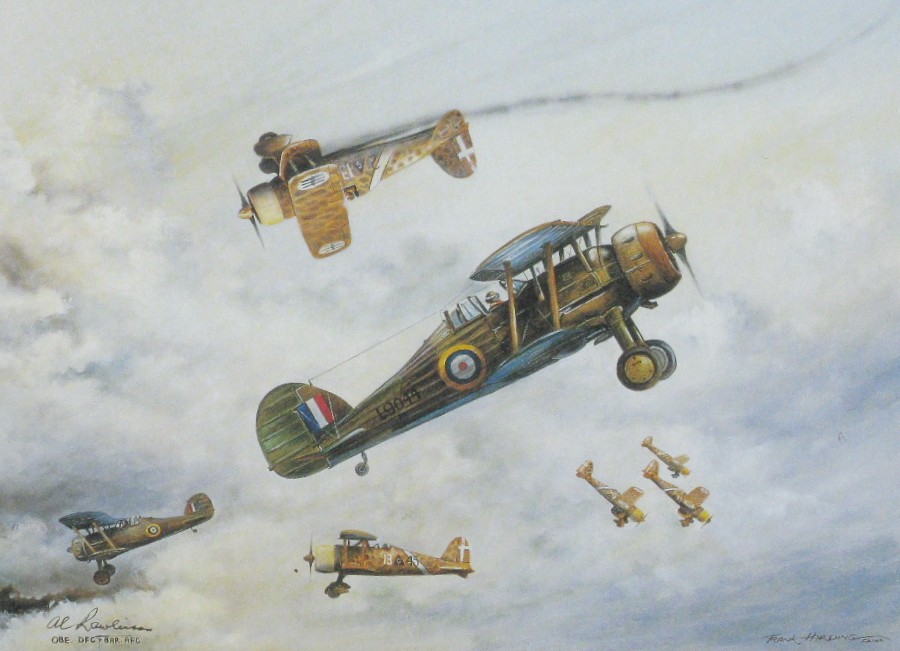Gladiators
were the last of the biplane fighters. They
were the descendants of the Pups, Camels and S.E.5As used by the
R.F.C., the R.N.A.S., [and the Australian Flying Corps] in World
War I. Their own particular
family tree was a complex and distinguished one. The
Gloster Gladiator was one of the most successful and illustrious
names in a long line of machines designed by Mr H. P. Folland. Its immediate ancestor was
the Gauntlet, and its prototypes the SS19b, the SS19, the SS18b,
and the SS18, a line of development which arose from Air
Ministry Specification F20/27.
In 1934 the G.37 was produced by the Gloster
Company to meet the requirements of Specification F7/30. This was the prototype Gladiator,
No. K5200. The prototype
machine lacked some of the more modern refinements which were to
be incorporated in the production model. It
had the old Gauntlet type cowling and 'spatted' tail wheel and
did not have the cockpit hood fitted to later machines. But
it did possess some modern and outstanding features. The
undercarriage
was of a new type. It employed
Dowty internally sprung streamlined wheels, and the old
cumbersome 'birdcage' of struts and bracing wires had been done
away with in favour of two graceful, knife-like single legs
inside which the six-inch travel of the Dowty gear absorbed all
shocks.
The
first delivery of Gladiators was made to the R.A.F. in 1937
under the new 'Expansion Scheme'. The
first squadrons to have them were Nos. 3(RAF),
56, and 72. They
soon found that Glosters had given them a winner. The
little single-bay biplane was robust and highly
manoeuvrable, so that it was exceptionally good for
aerobatics. The aircraft seemed
to have no faults. Soon, more
squadrons received the new machines: Nos. 17, 33, 54, 65, 73,
80, 87, 223, 247, 602 (City of Glasgow Squadron), 603
(City of Edinburgh Squadron), 607 (County of Durham Squadron)
and 615 (County of Surrey Squadron). The
Gladiator continued to show herself a star performer in the
aerobatic line. In 1938 at the
R.A.F. Air Show three of them flew chained together in V
formation. In 1939 the
naval version of the Gladiator, called the Sea-Gladiator, was
introduced into the Fleet Air Arm. This
version of the machine incorporated various special naval
fittings, including a deck-arrester hook, a dinghy and several
internal modifications.
All these machines
were Mark I Gladiators, which had the Bristol Mercury Mark 9
engine, another guarantee of quality performance. The
Mark 9 drove a fixed-pitch, two-bladed, wooden propeller.
Later the Mark II Gladiator was introduced, powered by the 840
horse-power Mercury 8A. At the
outbreak of war many of these were in service, large numbers of
them fitted with three-bladed,
fixed-pitch, Fairey-Reed metal
propellers. (The variable-pitch
propeller was an innovation which had not reached the
Gladiator.)
The
Gloster Gladiator was basically of all-metal construction, of
steel tube and strip. The
fuselage was of the Warren-girder type, with steel tubes and
internal wire bracing. The
wings were based upon two spars made of steel strip with steel
compression ribs and dural lattice ribs. The
whole aircraft was fabric-covered. The internal structure made for
great strength and durability. Little
did the men who planned and built the aircraft know what a
severe test this same structure would one day be put to.
Armament
consisted of four .303 machine
guns, two of them in the fuselage, firing forward between the
propeller blades by means of an interrupter gear, and two in
'blisters' under the wings. The
aircraft had a maximum speed of 250 m.p.h. at 15,500
feet, could climb to 15,000 feet in 5.8 minutes and
reached its ceiling at 32,800 feet. It
cruised at 210 m.p.h. and landed at 59 m.p.h. A
main tank and a gravity tank had a fuel capacity of 64
gallons and 20 gallons respectively.
The Gladiator was the last biplane to be
constructed by the Gloster Company and the last biplane to be
operationally employed by the R.A.F. and the R.A.A.F. A
total of five hundred and twenty-seven Gladiators were built
altogether and, of these, a total of two hundred and sixteen
were supplied to the governments of Belgium, China, Greece,
Finland, Iraq, the Irish Free State, Latvia, Lithuania,
Portugal, Norway and Sweden.
By the time war came, the Gladiator was on its
way out, and most frontline squadrons of the R.A.F. had been
re-equipped with Hurricanes. The
Gladiator, with its mixture of ancient and modern features, was
something of a transition type. But it was not a mongrel.
What it lacked in speed and
armament it made up for a great deal in manoeuverability,
reliability and sheer airworthiness. It
was in fact a pedigree machine, the final flower of the old,
sturdy, dog-fighting biplane fighters.
As such it was destined to uphold with great
honour the name of the old Air Force. The
Gladiator, so aptly named, was to carry the reputation the old
Royal Flying Corps gained against the German Air Force in World
War I into a second Great War, a war in which speeds had
trebled, and give it greater glory.
From the
very beginning of the war the Gladiators were in the thick of
the fight. Nos. 607 and 617
Squadrons took their Gladiators to France, where they
distinguished themselves. A
Gladiator from 603 Squadron scored one of the first air
victories of the war by shooting down a Heinkel III into the
Firth of Forth.
This was
the aircraft that the Air Force hoped to use to defend Malta and
the Middle East in the event of an attack by the Regia
Aeronautica - a tough, intensively airworthy little
aeroplane, but sadly out-dated by the modern machines of the
Italians.


